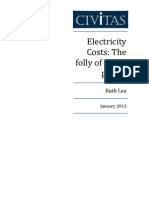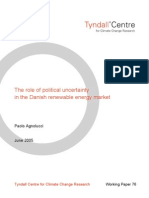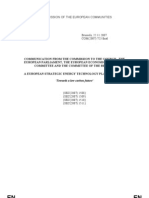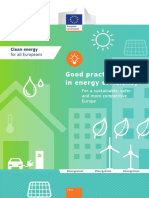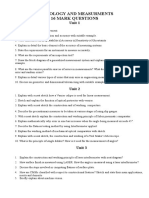Energy Efficiency Netherlands
Energy Efficiency Netherlands
Uploaded by
Jean Briham Pardo BaqueroCopyright:
Available Formats
Energy Efficiency Netherlands
Energy Efficiency Netherlands
Uploaded by
Jean Briham Pardo BaqueroOriginal Description:
Copyright
Available Formats
Share this document
Did you find this document useful?
Is this content inappropriate?
Copyright:
Available Formats
Energy Efficiency Netherlands
Energy Efficiency Netherlands
Uploaded by
Jean Briham Pardo BaqueroCopyright:
Available Formats
Energy Efficiency trends and policies in the Netherlands
Energy Efficiency Trends and Policies in the Netherlands 1
Date: September 2015
Contact person:
J. Gerdes, ECN, The Netherlands
Energy Efficiency Trends and Policies in the Netherlands 2
The sole responsibility for the content of this publication lies with the authors. It does not necessarily
reflect the opinion of the European Communities. The European Commission is not responsible for
any use that may be made of the information contained therein.
Energy Efficiency Trends and Policies in the Netherlands 3
TABLE OF CONTENTS
TABLE OF CONTENTS ...........................................................................................................................4
LIST OF FIGURES ...................................................................................................................................5
EXECUTIVE SUMMARY ..........................................................................................................................6
1. ECONOMIC AND ENERGY EFFICIENCY CONTEXT ...................................................................7
1.1. Economic context........................................................................................................................... 7
1.2. Total Energy consumption and intensities ..................................................................................... 7
1.3. Energy efficiency policy background .............................................................................................. 8
1.3.1. Energy efficiency targets ................................................................................................................ 8
2. ENERGY EFFICIENCY IN BUILDINGS ....................................................................................... 10
2.1. Energy efficiency trends ............................................................................................................... 10
2.2. Energy efficiency policies ............................................................................................................. 12
3. ENERGY EFFIENCY IN TRANSPORT ........................................................................................ 14
3.1. Energy efficiency trends ............................................................................................................... 14
3.2. Energy efficiency policies ............................................................................................................. 15
4. ENERGY EFFICIENCY IN INDUSTRY ........................................................................................ 16
4.1. Energy efficiency trends ............................................................................................................... 16
4.2. Energy efficiency policies ............................................................................................................. 16
5. ENERGY EFFICIENCY IN AGRICULTURE ................................................................................ 18
5.1. Energy efficiency trends ............................................................................................................... 18
5.2. Energy efficiency policies ............................................................................................................. 19
REFERENCES ...................................................................................................................................... 20
Energy Efficiency Trends and Policies in the Netherlands 4
LIST OF FIGURES
Figure 1.1 – GDP in billions of euros of 2005
Figure 1.2 – Index of primary and final energy consumption and primary and final energy intensity (euro/PJ), all
corrected for temperature
Figure 1.3 – Indices for GDP (corrected for inflation), final energy consumption and the energy efficiency index
ODEX
Figure 2.1 – Energy efficiency indices for households, households space eating and households electrical
appliances
Figure 2.2 – Total final consumption and consumption for space heating
Figure 2.3 –Average electricity consumption per dwelling
Figure 2.4 – Efficiency of large electric appliances
Figure 2.5 – Energy consumption in the services sector (not adjusted for temperature)
Figure 2.6 – Total energy intensity and electricity intensity in the services sector
Figure 2.7 – NEEAP3 and EED article 7 measure types by impact in the households sector
Figure 3.1 – Final energy consumption in the transport sector, excluding international air transport
Figure 3.2 – Energy efficiency index for transport, including and excluding air transport
Figure 3.3 – Average specific consumption of all cars and of new cars in the Netherlands and in the EU
Figure 4.1 – Energy efficiency developments in industry (ODEX) and three branches. The index for chemistry is
based on energy intensity (energy per added value instead of physical production)
Figure 4.2 - NEEAP3 and EED article 7 measure types by impact in the industry sector
Figure 5.1 – Energy input and production of electricity and heat by CHP in agriculture
Figure 5.2 – Total energy consumption in agriculture before and after correction for CHP and data revision
Figure 5.3 – Energy input and produced heat and electricity of CHP in agriculture
Energy Efficiency Trends and Policies in the Netherlands 5
EXECUTIVE SUMMARY
The overall energy efficiency improvement rate for The Netherlands from 2000 to 2012 as derived from the
ODEX efficiency index was 1.5%/year. For households the improvement rate was 2.5%, for industry 2.6% and
for transport (excluding air transport) 0.6%. The effects of the economic crisis are clearly visible in lower
efficiency improvements after 2008, when the overall improvement rate went down to just 0.6%/year.
National policies contributing most to energy savings were the high energy tax, the range of agreements with
industry, agriculture, social housing and goods transport, and the vehicle tax stimulating efficient cars. Effective
EU policy measures were the energy performance for buildings directive EPBD, the Ecodesign directive for large
electric appliances and differentiating taxes for cars depending on their fuel economy.
Energy Efficiency Trends and Policies in the Netherlands 6
1. ECONOMIC AND ENERGY EFFICIENCY CONTEXT
1.1. ECONOMIC CONTEXT
Until the economic crisis of 2007/2008, the average annual growth of the GDP was 2% per year. The economic
crisis is clearly visible in the trend break for GDP of the Netherlands in 2008 (see fig 1.1). Corrected for inflation
the GDP was still lower in 2013 than it was in 2007.
Figure 1.1 – GDP in billions of euros of 2005 (source: Odyssee)
The crisis has had a significant impact on the progress of energy efficiency as we will see later.
1.2. TOTAL ENERGY CONSUMPTION AND INTENSITIES
The total primary energy consumption has increased until 2007, while the final consumption remained more or
less stable between 2000 and 2012 (see figure 1.2). The primary energy intensity (primary energy consumption
per unit of GDP) has increased up to 2005 and then decreased. Final energy intensity has been decreasing after
2005, but the progress has slowed considerably since the economic crisis of 2007/2008.
Figure 1.3 shows the GDP, the final energy consumption and the ODEX, which is the energy efficiency index
for all end-use sectors. The ODEX relates energy consumption to the quantities that define energy demand
(number of dwellings, output of industry, person-km in transport), something the energy intensity does not do.
Energy efficiency of final consumers has improved by 17% between 2000 and 2012, which translates into an
average gain of 1.5% per year. Since the start of the economic crisis, the improvement rate was lower (0.6%),
probably due to a lower addition of (much more efficient) new dwellings to the dwelling stock, less optimal
energy consumption in industry due to only partly used process capacity, and less investments in new energy
using devices. The efficiency improvement derived from the Odyssee index ODEX is higher than the
improvement of 1.1% found for 2000 – 2012 in the report about the national energy savings in The Netherlands
by ECN [ECN, 2012]. This can be explained by the different methodology like the inclusion of savings in energy
supply and CHP.
Energy Efficiency Trends and Policies in the Netherlands 7
Figure 1.2 – Index of primary and final energy consumption and primary and final energy intensity (euro/PJ), all
corrected for temperature (2000=100) (source: Odyssee)
Figure 1.3 – Indices for GDP (corrected for inflation), final energy consumption and the energy efficiency index
ODEX (2000 = 100) (source: Odyssee)
1.3. ENERGY EFFICIENCY POLICY BACKGROUND
1.3.1. ENERGY EFFICIENCY TARGETS
Energy Efficiency policy is coordinated by the Ministry of Economic Affairs in collaboration with other ministries
covering the transport and buildings sectors. In September 2013, more than 40 parties, including government,
have concluded the Energy Agreement ( [Energieakkoord, 2013]) for sustainable growth. Investments in energy
savings should lead to 100 PJ extra savings, bringing the yearly energy efficiency improvement until 2020 at a
level of 1.5% per year. The extra savings should be realized mainly in dwellings and buildings, but also industry,
transport and agriculture should contribute. The Agreement builds on earlier policy formulated in the “Clean
and Efficient” (in Dutch: Schoon en Zuinig) programme.
For years, the basis of energy efficiency policy has been a collection of national cross-cutting measures such as
energy taxation (one of highest in Europe), programmes with supporting measures (information on saving
options, pilot projects and subsidies) and various voluntary agreements for end-use sectors. The Energy
Energy Efficiency Trends and Policies in the Netherlands 8
Agreement can be seen as the latest and broadest example of such agreements.
EU derived policy also plays a large role; in minimum efficiency standards for appliances (Ecodesign directive),
the strengthening of standards for new dwellings or buildings and labels for existing ones (EPBD), a higher
average efficiency of cars due to the EU car standard, and industrial savings due to the Emission Trading
Scheme. New EED policy, such as on the introduction of smart meters (EED art. 9-11), has been transposed
into national legislation. Strengthened existing policies could cover most other EED policy: the exemplary role
of the public sector (art. 5), purchasing by public bodies (art. 6), regular audits and energy management
systems (art. 8), info for consumers (art. 12), cost-effective heating/cooling through district heating (art. 14),
efficiency in transport and distribution (art. 15), EES (energy efficiency services) quality system (art. 16),
education of EES suppliers (art. 17) and EES market stimulation (art.18).
Other measures are targeted at split incentives, access to the grid and introduction of a revolving fund (art. 19
and 20). In 2013 a revolving fund for savings in buildings has been created, with 150 million euro of
government and 450 million from market parties.
Energy Efficiency Trends and Policies in the Netherlands 9
2. ENERGY EFFICIENCY IN BUILDINGS
2.1. ENERGY EFFICIENCY TRENDS
Households
The energy efficiency in households has made a lot of progress since 2000. The efficiency of space heating
increased especially quickly until 2007, after which it slowed down because less new and efficient new
dwellings were built due to the economic crisis. The electrical appliances show a more steady improvement.
The average efficiency improvement rate between 2000 and 2012 was 2.5%/year.
Figure 2.1 – Energy efficiency indices for households, households space eating and households electrical
appliances (2000 = 100) (source: Odyssee)
Figure 2.2 shows that the energy consumption trend follows the consumption for space heating, being
responsible for the majority of energy consumption in households. The efficiency of space heating has
increased due to better insulation and a larger share of condensing boilers.
Figure 2.2 – Total final consumption and consumption for space heating (source: Odyssee)
The consumption of electricity per dwelling has remained more or less constant (see figure 2.3), although the
Energy Efficiency Trends and Policies in the Netherlands 10
consumption of large appliances has decreased considerably (see figure 2.4). The stabilisation of electricity
consumption despite the efficiency gains in large appliances is caused by the increased ownership of other
electrical appliances like IT and media appliances.
Figure 2.3 –Average electricity consumption per dwelling (source: Odyssee)
Figure 2.4 – Efficiency of large electric appliances (source: Odyssee)
Energy Efficiency Trends and Policies in the Netherlands 11
Services
In the services sector, electricity consumption forms a larger share of total consumption than in the households
sector, and it is growing with 1.7%/year, see figure 2.5.
Figure 2.5 – Energy consumption in the services sector (not adjusted for temperature) (source: Odyssee)
The energy intensity (energy use per Euro Value Added) in the Services sector does not show a clear trend,
other than a rise in electricity intensity in recent years, see figure 2.6. There is no clear difference between
energy intensity developments in different services sectors.
Figure 2.6 – Total energy intensity and electricity intensity in the services sector (2000 = 100) (source: Odyssee)
2.2. ENERGY EFFICIENCY POLICIES
For buildings, the continuously strengthened standards for new dwellings (for which the energy performance
coefficient decreased from 1.4 in 1996 to 0.4 in 2015) and buildings has provided a large part of all policy
savings, increasing from 5 to 33 PJ for the period 2008-2012. For existing dwellings, various agreements have
been concluded with social housing corporations. As part of a new policy on social housing 400 million euro of
subsidies are available to stimulate investments for savings. The new Energy Agreement, with all relevant
Energy Efficiency Trends and Policies in the Netherlands 12
players (landlords, energy companies and the construction sector), should lead to extra savings. Currently,
savings are estimated at 13-43 PJ, especially for owners of dwellings, with help of a new fund and the
renovation strategy (article 4) which is also part of the Agreement. Figure 2.7 shows the policy measure types
for EED article 7 and NEEAP3. The measures with the highest impact are legislative/normative and cooperative
measures.
Legend of the Graph Labels
Coop: Co-operative Measures
Cros: Cross-cutting with sector-specific
characteristics
Fina: Financial
Fisc: Fiscal/Tariffs
Info: Information/Education
Le/I: Legislative/Informative
Le/N: Legislative/Normative
Figure 2.7 – NEEAP3 and EED article 7 measure types by impact in the households sector (source: Mure)
Energy Efficiency Trends and Policies in the Netherlands 13
3. ENERGY EFFIENCY IN TRANSPORT
3.1. ENERGY EFFICIENCY TRENDS
Energy consumption in the transport sector (excluding international air transport) decreased in recent years,
but has not fallen below the level of 2000, see figure 3.1. Just over half of all the energy consumed in transport
is used by cars. The consumption of cars, trucks and light vehicles peaked in 2008.
Figure 3.1 – Final energy consumption in the transport sector, excluding international air transport (source:
Odyssee)
The energy efficiency of the transport sector as a whole increased by 13% since 2000 as a result of relatively
large savings for air transport, including international flights. The more relevant index for the Netherlands
excludes air transport, as air transport is not targeted in national policies and incorporating it would conceal
the actual efficiency figures for domestic transport.
The energy efficiency gains in the transport sector are less than in other sectors, see figure 3.2. The index
without air transport leads to an average efficiency improvement rate of 0.6%/year.
Energy Efficiency Trends and Policies in the Netherlands 14
Figure 3.2 – Energy efficiency index for transport, including and excluding air transport (source: Odyssee)
3.2. ENERGY EFFICIENCY POLICIES
For goods transport, the major policy measure has been the long term agreements with measures on logistics,
the drag coefficient of trucks and better driving behaviour. For cars, the eco-driving scheme has been of
importance. Recently, the amended purchasing tax (Dutch: BPM) has stimulated the purchase of more efficient
cars that entered the market due to the EU car standard. This has led to a much larger shift to small and
efficient new cars compared to other EU countries, see figure 3.3.
Figure 3.3 – Average specific consumption of all cars and of new cars in the Netherlands and in the EU (source:
Odyssee)
Energy Efficiency Trends and Policies in the Netherlands 15
4. ENERGY EFFICIENCY IN INDUSTRY
4.1. ENERGY EFFICIENCY TRENDS
Figure 4.1 shows the energy efficiency improvements in industry as a whole (ODEX) and for the three most
energy consuming branches. The energy efficiency progress in the manufacturing industry was 27% between
2000 and 2012, or 2.6% per year.
In the chemical industry the improvement was 3.9% per year, but stalled after 2007. Unlike other industrial
branches, the improvement for the chemical industry is not based on energy consumption per unit of physical
production because these are difficult to retrieve and thus are not used in the Odyssee project. The
improvement is based on energy intensity, which compares energy consumption to added value. Therefore, it
also includes shifts to products with a higher added value. This most probably leads to a higher value of the
efficiency improvement for the chemical industry. The energy efficiency of the steel industry improved little
(0.7% per year) and also showed negative effects of the economic crisis, especially in 2009. The overall
improvement for the steel industry since 2000 was just 8%.
The energy efficiency in the paper industry was 24% and does not show a negative effect of the crisis at all.
Actually, the rate of increase in efficiency was higher after 2007 with 3.6% per year.
Figure 4.1 – Energy efficiency developments in industry (ODEX) and three branches. The index for chemistry is
based on energy intensity (energy per added value instead of physical production) (2000 = 100) (source:
Odyssee)
4.2. ENERGY EFFICIENCY POLICIES
In industry there are various Long-Term Agreements (LTA) on Energy Efficiency, for ETS enterprises the MEE
agreement (from 2008) and for smaller energy users the LTA-3. Together with tax deduction for investments in
energy savings (EIA) these policy measures account for almost all policy related savings in industry, as the price
of emission rights in the ETS has been too low to stimulate savings.
ETS is not very effective due to a high supply of emission allowances and low prices. Relatively few, and weak,
Energy Efficiency Trends and Policies in the Netherlands 16
policy measures are in place due to the (perceived) overlap of other policies with ETS.
The most effective measures are fiscal and cooperative ones, see figure 4.2.
Legend of the Graph Labels
Coop: Co-operative Measures
Cros: Cross-cutting with sector-specific
characteristics
Fina: Financial
Fisc: Fiscal/Tariffs
Info: Information/Education
Le/I: Legislative/Informative
Le/N: Legislative/Normative
Figure 4.2 - NEEAP3 and EED article 7 measure types by impact in the industry sector (source: Mure)
Energy Efficiency Trends and Policies in the Netherlands 17
5. ENERGY EFFICIENCY IN AGRICULTURE
5.1. ENERGY EFFICIENCY TRENDS
Horticulture is by far the largest energy consumer in the agriculture sector in the Netherlands. Combined heat
and power plays a large role in the Dutch horticulture sector, see figure 5.1.
Figure 5.1 – Energy input and production of electricity and heat by CHP in agriculture (source: CBS)
Figure 5.2 shows the total energy consumption of the agriculture sector corrected for the CHP effect (excluding
input for CHP and including final use of electricity and heat from CHP). Data for recent years have also been
updated, which lowers the consumption in 2012 and 2013. Comparing the added value of the agriculture sector
with the corrected energy consumption leads to an energy intensity improvement of 2.3%/year between 2000
and 2013.
Figure 5.2 – Total energy consumption in agriculture before and after correction for CHP and data revision
(source: Odyssee, CBS)
The amount of electricity produced by CHP surpasses the electricity consumed within the agriculture sector
which makes the agriculture sector a net producer of electricity, see figure 5.3.
Energy Efficiency Trends and Policies in the Netherlands 18
Figure 5.3 – Energy input and produced heat and electricity of CHP in agriculture (source: CBS)
5.2. ENERGY EFFICIENCY POLICIES
Since 2008 all actions from the LTA have been stopped when the Action Programme for Clean and Economical
Agro sectors (Convenant ‘Schone en Zuinige Agrosectoren’) was signed and energy became part of this. This
Action programme is an agreement of the central government and ten organisations, representing the
agricultural sector: LTO Nederland, KAVB, LTO Glaskracht Nederland, Produktschap Tuinbouw, Vereniging
Platform Hout, Bosschap, FNLI, Produktschap Akkerbouw Nevedi en Platform Agrologistiek.
The Clean and Economical Agro-Sectors agreement sets specific objectives for aspects such as energy efficiency
improvements for greenhouse cultivation, livestock farming, arable farming and bulb and mushroom growing
for the period up to the end of 2020. One of the targets, also included in NEEAP3, is improved energy efficiency
for the horticulture by 43% (compared to 1990).
Energy Efficiency Trends and Policies in the Netherlands 19
REFERENCES
ECN, 2012: Energiebesparing in Nederland 2000 – 2012, Gerdes J. and Boonekamp P.G.M., ECN-E--12-061,
https://www.ecn.nl/publicaties/ECN-E--12-061
Energieakkoord, 2013: http://www.energieakkoordser.nl/
Energy Efficiency Trends and Policies in the Netherlands 20
You might also like
- 2012 BUILDING AUTOMATION AND ENERGY EFFICIENCY - THE EN 15232 STANDARD - Leonard PDFDocument18 pages2012 BUILDING AUTOMATION AND ENERGY EFFICIENCY - THE EN 15232 STANDARD - Leonard PDFbdsrlNo ratings yet
- Best Practices Writing Production-Grade PySpark JobsDocument11 pagesBest Practices Writing Production-Grade PySpark JobsRahul DasNo ratings yet
- D 5093 - 90 R97 - RduwotmtukveDocument9 pagesD 5093 - 90 R97 - RduwotmtukveAlejandro MuñozNo ratings yet
- Plano Hidráulico Cargador 988GDocument13 pagesPlano Hidráulico Cargador 988Ggerardo100% (2)
- Energy Efficiency Policies and Measures in CyprusDocument67 pagesEnergy Efficiency Policies and Measures in CyprusAndreas MichaelNo ratings yet
- 10 1016@j Energy 2019 116526 PDFDocument31 pages10 1016@j Energy 2019 116526 PDFMohamed Yassine LahianiNo ratings yet
- Impact Assessment 2Document114 pagesImpact Assessment 2rocosanaNo ratings yet
- Netherlands Country Profile EnglishDocument11 pagesNetherlands Country Profile EnglishSanket ManeNo ratings yet
- ODYSSEE MURE Report 2015Document97 pagesODYSSEE MURE Report 2015SDC WUENo ratings yet
- Greece Country Profile EnglishDocument9 pagesGreece Country Profile Englishmmendez113No ratings yet
- Final Report Levelised Costs 0Document62 pagesFinal Report Levelised Costs 0Panaya SudtaNo ratings yet
- 2020 Energy Consumption in The UK ECUKDocument33 pages2020 Energy Consumption in The UK ECUKNakaret KanoNo ratings yet
- Economic Aspects of The Energy Efficiency Projects in Buildings in EU Countries Compared To Southeast European CountriesDocument12 pagesEconomic Aspects of The Energy Efficiency Projects in Buildings in EU Countries Compared To Southeast European CountriesDubravkaNo ratings yet
- Cheze Et al-EJ-2020 PostPrintDocument39 pagesCheze Et al-EJ-2020 PostPrintffarhat904No ratings yet
- Domestic Energy FactsheetDocument10 pagesDomestic Energy Factsheetdcc1973No ratings yet
- CZ Neeap Update 2-2016 en 3 PDFDocument95 pagesCZ Neeap Update 2-2016 en 3 PDFApolo FumbujaNo ratings yet
- The EURELECTRIC Energy Wisdom Programme (EWP) : Improving Energy Efficiency Reducing Carbon Emissions Meeting The 2050 ChallengesDocument68 pagesThe EURELECTRIC Energy Wisdom Programme (EWP) : Improving Energy Efficiency Reducing Carbon Emissions Meeting The 2050 ChallengesDimitrios MavromatidisNo ratings yet
- Hypostat 2013Document4 pagesHypostat 2013RUTHNo ratings yet
- 6922 A Guide To Financing Energy Efficiency in The PublDocument21 pages6922 A Guide To Financing Energy Efficiency in The PublAbadi GebrehiwotNo ratings yet
- 2015-12-09 Securing Energy Effciency To Secure The Energy Union Executive SummaryDocument8 pages2015-12-09 Securing Energy Effciency To Secure The Energy Union Executive Summaryandy131078No ratings yet
- Energy EfficiencyDocument19 pagesEnergy EfficiencyRetro ParadiesNo ratings yet
- Uk Energy CrisisDocument9 pagesUk Energy CrisisAnonymous nqgDQZwxNo ratings yet
- Energy EfficiencyDocument34 pagesEnergy EfficiencyDiego ArimateiaNo ratings yet
- European Policies On Climate and EnergyDocument12 pagesEuropean Policies On Climate and EnergyanterogerNo ratings yet
- PV CostDocument20 pagesPV CostDBachai84No ratings yet
- International Comparisons Energy EfficiencyDocument8 pagesInternational Comparisons Energy EfficiencyMoldoveanu BogdanNo ratings yet
- Assessing The Impact of A Carbon Tax in Ukraine: Miriam FreyDocument24 pagesAssessing The Impact of A Carbon Tax in Ukraine: Miriam FreyPutri AyuNo ratings yet
- Premium Light Pro Project ID 695931Document26 pagesPremium Light Pro Project ID 695931optimusehagerNo ratings yet
- Energies: Italian Biogas Plants: Trend, Subsidies, Cost, Biogas Composition and Engine EmissionsDocument31 pagesEnergies: Italian Biogas Plants: Trend, Subsidies, Cost, Biogas Composition and Engine EmissionsHuy ĐoànNo ratings yet
- Energy Economic Developments in EuropaDocument160 pagesEnergy Economic Developments in EuropaAna AlexandraNo ratings yet
- 2020 ECUK Press NoticeDocument4 pages2020 ECUK Press NoticeergtewfgergNo ratings yet
- 2050 EU Energy Strategy ReportDocument7 pages2050 EU Energy Strategy ReportHector Parra MolinaNo ratings yet
- Policy Paper (Name of Author) (Name of Institution)Document27 pagesPolicy Paper (Name of Author) (Name of Institution)Asra Tufail DahrajNo ratings yet
- Energy Climate Change: World Energy Outlook Special Briefing For COP21Document11 pagesEnergy Climate Change: World Energy Outlook Special Briefing For COP21amrialifaNo ratings yet
- 2009 Eeap Background Document PDFDocument8 pages2009 Eeap Background Document PDFIgor NeagaNo ratings yet
- Elearning Clean Energy Package 032020Document16 pagesElearning Clean Energy Package 032020AnanyaNo ratings yet
- United Kingdom 2012Document19 pagesUnited Kingdom 2012rodrigo_andsNo ratings yet
- Electricity Costs: The Folly of Wind-Power: Ruth LeaDocument49 pagesElectricity Costs: The Folly of Wind-Power: Ruth Leatjones_476150No ratings yet
- The Role of Political Uncertainty in The Danish Renewable Energy MarketDocument21 pagesThe Role of Political Uncertainty in The Danish Renewable Energy MarketTyndall Centre for Climate Change ResearchNo ratings yet
- 5thEED AnnualReport 072021 NMDocument13 pages5thEED AnnualReport 072021 NMmirkomakNo ratings yet
- Energy Efficiency FinlandDocument64 pagesEnergy Efficiency FinlandAksMastNo ratings yet
- EN EN: European CommissionDocument14 pagesEN EN: European CommissionLim ChintakNo ratings yet
- The Changing of The Electric and Nonelectric Energy Production and Technology Options For Emission Abatement On IndonesiaDocument12 pagesThe Changing of The Electric and Nonelectric Energy Production and Technology Options For Emission Abatement On IndonesiapaparezaNo ratings yet
- EN EN: Commission of The European CommunitiesDocument14 pagesEN EN: Commission of The European Communitiesuakauaka31416No ratings yet
- Denmark r04Document38 pagesDenmark r04kalokosNo ratings yet
- Transformers ScopeDocument60 pagesTransformers ScopeSathiya KumarNo ratings yet
- EURELECTRIC Report: Environment and Sustainable Development - Edition 2012Document92 pagesEURELECTRIC Report: Environment and Sustainable Development - Edition 2012Dimitrios MavromatidisNo ratings yet
- Good PracticeDocument50 pagesGood PracticeRamasubramanian Sankaranarayanan100% (1)
- Geothermal RoadmapDocument52 pagesGeothermal RoadmapJorge L Corsi MonteroNo ratings yet
- Paper ID 159Document6 pagesPaper ID 159Varanasi AnilNo ratings yet
- Spain Country Profile EnglishDocument13 pagesSpain Country Profile EnglishSanket ManeNo ratings yet
- Policy Discussion PaperDocument8 pagesPolicy Discussion PaperLuis PlascenciaNo ratings yet
- Challenge: The Energy EfficiencyDocument12 pagesChallenge: The Energy EfficiencyIvana StevanovićNo ratings yet
- 1670145088pdfemissions From Electricity Policy Brief-2Document8 pages1670145088pdfemissions From Electricity Policy Brief-2cpuali44No ratings yet
- Republic of Mauritius Long-Term Energy Strategy 2009 - 2025Document56 pagesRepublic of Mauritius Long-Term Energy Strategy 2009 - 2025Mirnal MungraNo ratings yet
- Portugal Country Profile EnglishDocument9 pagesPortugal Country Profile EnglishSanket ManeNo ratings yet
- Residential Energy Efficiency Policy in Latvia A Sistem Dynamics ApproachDocument23 pagesResidential Energy Efficiency Policy in Latvia A Sistem Dynamics Approachjhon contrerasNo ratings yet
- Energy Credits Trading Final ReportDocument16 pagesEnergy Credits Trading Final ReportDeepak KukretyNo ratings yet
- Interreg Efici EnergéticaDocument18 pagesInterreg Efici EnergéticaAldina AndradeNo ratings yet
- Energy Efficiency Strategical Document 2012Document18 pagesEnergy Efficiency Strategical Document 2012chevirmenNo ratings yet
- Understanding Energy EfficiencyDocument10 pagesUnderstanding Energy EfficiencyRicardoNo ratings yet
- EU China Energy Magazine 2023 Summer Double Issue: 2023, #7From EverandEU China Energy Magazine 2023 Summer Double Issue: 2023, #7No ratings yet
- EU China Energy Magazine 2021 Autumn Issue: 2021, #3From EverandEU China Energy Magazine 2021 Autumn Issue: 2021, #3No ratings yet
- Anti-Theft ImmobilizerDocument43 pagesAnti-Theft ImmobilizerNick PNo ratings yet
- Law Feedback Paper 1Document12 pagesLaw Feedback Paper 1momanbhNo ratings yet
- Ca3162 ADocument7 pagesCa3162 Ajnax101No ratings yet
- Culture9 090801103430 Phpapp02Document124 pagesCulture9 090801103430 Phpapp02Tarek FahimNo ratings yet
- Computer Network - PPT Slides Kurose Ross 4rd EditionDocument8 pagesComputer Network - PPT Slides Kurose Ross 4rd EditionWladimir VergalNo ratings yet
- S S.R R D C E: Apadiya OhammadaadilDocument20 pagesS S.R R D C E: Apadiya OhammadaadilChemical Engg.No ratings yet
- 7 Stages Research process-WPS OfficeDocument4 pages7 Stages Research process-WPS OfficeSohail MirzaNo ratings yet
- TSRS ML PGN 2009 With CommentsDocument4 pagesTSRS ML PGN 2009 With Commentsmaharani_nurvlidaNo ratings yet
- WBJEE Info Brochure PDFDocument71 pagesWBJEE Info Brochure PDFUtsyo ChakrabortyNo ratings yet
- On Public Distribution System of IndiaDocument10 pagesOn Public Distribution System of Indiaadityahongkong0% (1)
- Nestle Milk Pack Moving Average Forecasting Method: Trend AnalysisDocument5 pagesNestle Milk Pack Moving Average Forecasting Method: Trend AnalysisrajaumerzNo ratings yet
- Currency: Satya IAS AcademyDocument2 pagesCurrency: Satya IAS AcademyKiranKiranNo ratings yet
- BT Vector GBDocument338 pagesBT Vector GBGiorgio GiuntaNo ratings yet
- Revised Cyber or Digital LiteracyDocument11 pagesRevised Cyber or Digital LiteracySonia Pineda RiveraNo ratings yet
- Pac ZamilDocument41 pagesPac ZamilasindonNo ratings yet
- TCS SIEBEL EIM Data Migration Approach in Highly Secured EnvironmentDocument7 pagesTCS SIEBEL EIM Data Migration Approach in Highly Secured Environmentstephenraj_siebelNo ratings yet
- M4 ManualDocument20 pagesM4 Manualamit64007No ratings yet
- SNDocument5 pagesSNAziz Milanisty SejatieNo ratings yet
- Level 3 Hamsae InstituteDocument6 pagesLevel 3 Hamsae InstituteIvana ArleneNo ratings yet
- 16 Marks Metrology and MeasurmentsDocument2 pages16 Marks Metrology and MeasurmentsRajasekar ChockalingamNo ratings yet
- Multilabel Feature Selection: A Comprehensive Review and Guiding ExperimentsDocument29 pagesMultilabel Feature Selection: A Comprehensive Review and Guiding ExperimentsRahul kumarNo ratings yet
- Synchronous Ethernet and IEEE 1588v2 Technology White PaperDocument24 pagesSynchronous Ethernet and IEEE 1588v2 Technology White PapertsatskiNo ratings yet
- Trasmisor de Presión Winter InstrumentsDocument2 pagesTrasmisor de Presión Winter InstrumentsDiego Nicolas Figueroa QuirozNo ratings yet
- Pegadora B Bq240Document79 pagesPegadora B Bq240AlbhertoalonsoNo ratings yet
- IT Careers & Networking: Paul Patti, PH.DDocument25 pagesIT Careers & Networking: Paul Patti, PH.DBeyNo ratings yet
- SolidCAM 2016 5 Axis Basic TrainingDocument105 pagesSolidCAM 2016 5 Axis Basic TrainingThanh NguyenNo ratings yet
- Injection Molding Machine Error Codes Alarms With Techmation ControllerDocument7 pagesInjection Molding Machine Error Codes Alarms With Techmation ControllerarijitoNo ratings yet





































